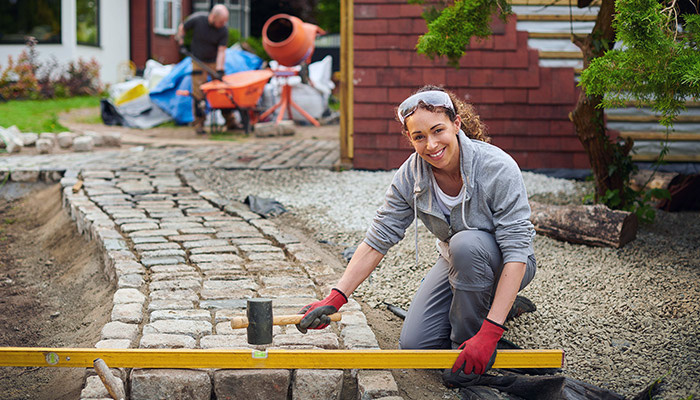
Summer is here – and with it, home improvement season! Are you wondering how to pay for home improvements, or how to finance a home renovation? Don’t sweat – we’ll walk you through how to launch the home makeover of your dreams, step by step.
So, are you ready to get started?
Budget, Budget, Budget
The first step to giving that old dining room a facelift is to build a budget. Even small home improvement projects should begin with a solid budget – especially as the cost of materials keeps climbing.
No matter what you plan to do around the house, you’ll want to research how much the project should cost. Keep in mind that price ranges will vary depending on your area and the current cost of materials, but a little Googling beforehand can give you a solid estimate to work with.
Next, decide how much you want to spend. Do you plan to do the work yourself, or hire a contractor? Both avenues have different pros and cons and can greatly impact your final budget.
If you choose to go with a contractor, start requesting estimates from several local professionals. Requesting “bids” from several people will allow you to choose the most reasonable price and allow you to factor that into your budget.
You’ll also want to set aside some additional funds for a contingency budget. A contingency budget is an extra pot of money you have set aside to use in case things go wrong, or in case renovations uncover additional problems. If something breaks, or a pipe bursts, or if paint gets spilled all over your carpet, a contingency budget is there to help you clean up. Expects say that a contingency budget should be around 10 percent of your overall project budget. It may seem like a lot – but if you don’t use it, you can put that money back into your pocket!
And don’t forget to factor in the cost of materials! Some building materials are at an all-time high right now, so you’ll definitely want to do some research ahead of time to ensure you have the appropriate funds. After all, no one wants to get halfway through a project and then run out of timber.
If you need help budgeting a home renovation, try using one of our financial calculators!
Arrange Financing
Depending on what you plan to do, there are typically two options when it comes to paying for home improvements. You can either save up for them slowly, or take out a loan.
It really comes down to a matter of personal preference, as well as equity, credit score, and what you plan to have done. Saving up for a project may be the more ideal option for smaller home improvements, while a larger project – say a kitchen remodel – may be easier to pay for with a loan. But it’s all up to you!
If you plan to get a loan, you may want to look into a Home Equity Line of Credit – or HELOC – to help cover costs. You can also get a personal loan. If you have additional questions on financing, your local banker should be able to provide some guidance and help you get started.
If you plan to pay for expenses out of pocket, make sure you have an airtight budget, and be aware that you might be saving for quite a while, depending on your salary and the project cost.
Either way, you’ll want to make sure you have the cash in hand before you start any home improvements. So, once you’ve built your budget, make sure you finalize your financing.
Saving Money
There are ways to save money when doing home improvements – even if you decide to swing for a contractor.
You can take down counters, tear up carpet, or pull out tile yourself, which will allow you to save some money in labor costs. You can also add the finishing touches – such as installing fixtures and painting – yourself, to save even more.
Just be careful not to make any big changes, such as knocking out a wall, without a contractor signing off on it. If that wall is load bearing, you may end up going over budget to repair it!
Prioritize
Very few people are able to knock out their entire list of home improvements at once. Make sure you’re prioritizing projects – especially when it comes to financing. If you have a broken window, for instance, it may not be the right time to redecorate your living room.
Try starting a list and ranking projects from most to least important, and then work your way slowly down the list. It may take a while for you to get to every project, but that’s ok! A house is a long-term investment, after all.
No matter what you choose to do, it looks like it will be a busy summer, and we wish you luck!

